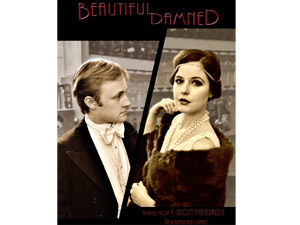
F. Scott Fitzgerald defined an era with his novels but his attempts at writing plays were unsuccessful. His main effort, The Vegetable, premiered in 1923 in Atlantic City but failed to make the leap to Broadway. With much of his writing now in the public domain other attempts can be made to stage his work. Beautiful Damned has been adapted by Ben Weaver-Hincks from Fitzgerald’s second novel The Beautiful and Damned. Is it possible to succeed where Scott himself failed?

The lounge at the Leicester Square Theatre is an intimate space with a built-in speak-easy, Jazz Age atmosphere. Throw in a candlestick phone, a pack of cards and a glass or two of bourbon and the louche mood of the Twenties starts to grow. James Hyde’s Anthony Patch, complete with spats adds to the feeling, though it is Nadia Cavelle’s costume that sends us right back to Fitzgerald’s time. As Gloria she is an elegant flapper, in fringed dress and headband, smoking never-ending cigarettes. She never quite dances the Charleston, but in her elbow-length gloves you feel that if she had to she’d nail it.
Anthony and Gloria are young, rich and idle – and very much based on Scott and his wife Zelda. The novel progresses in chronological order but here we meet them in a bar when their hopes have already crashed and their monied adventures have ended. Through flash backs and reminiscences we see important moments in their lives, often, but not always revolving around alcohol and partying.
Having got married Gloria has pretty much achieved her life aims. Anthony has pretensions to writing, but is really waiting for his grandfather to die and leave him the millions of dollars he made on Wall Street. Built from Scott’s dialogue the script reminds of his elegant prose. But it shows how much is lost by the transfer to the stage. As was discovered in the Twenties, his work is best read and unlinked from his language and description what’s left is a light weight story. In the book one of the characters comments on the different needs of scripts to novels, “…Of course the main thing in a moving picture is a strong story.” What The Beautiful and Damned does not have is a strong story.
Catrin Powell’s lighting design gives a soft hue to the reminiscing whilst Guy Hughes’ gentle piano accompaniment adds much to the mood, particularly as the audience is gathering, but feels over used. The two central performances are accomplished. Hyde captures the effete dissipation of Anthony, his pointless waste of potential and privilege. Cavelle reproduces the destructive quality that Fitzgerald’s women so often exude. Throughout the play they both take on other characters, successfully slipping into other voices and mannerisms to portray some of the couple’s drinking partners or lovers. In one amusing vignette they even play each other, Anthony waving his fan and checking his nails, Gloria more heartlessly parodying her husband’s indecision.
The book on which the play is based is recommended reading. Beautiful Damned cannot help losing the nuance and elegance of Scott’s descriptions but it is an atmosphere piece, summoning up the decadent Twenties, disappointed lives and glamorous decline.

Leave a Reply